Fishing with a feeder is relatively new way fishing. This bottom tackle was invented by the British in the middle of the 20th century, and the name translates as “feeder” (from the word to feed). The essence of fishing with a feeder is constant feeding with frequent re-casting of the bait to a new place - every 5-15 minutes. Feeder fishing is most suitable for reservoirs with standing water and weak currents. In places with strong water movement, the bait is quickly washed out of the feeder, and its smell is carried away. Naturally, fish are caught on the feeder, looking for food on the bottom and above it. This tackle is most suitable for fishing for carp, carp, bream, chub, silver bream, ide and, of course, you can perfectly catch crucian carp with a feeder, which we’ll talk about now.
What is a feeder
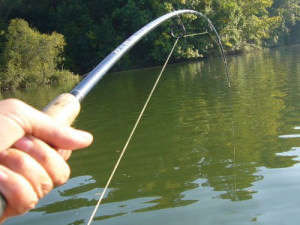 Feeder fishing set
Feeder fishing set If you look at the essence of the feeder, it’s the same donkey, but improved. It consists of standard parts:
- fishing rods;
- coils;
- fishing lines;
- leash;
- hook;
- feeders with bait.
But for successful feeder fishing, increased demands are placed on each element.
Feeder rod
There are no special requirements for length - whatever fishing rod is convenient for the fisherman, let him take that one. For reservoirs with depths immediately near the shore, a short model is more suitable; for shallow places (less than 3 meters) a long rod is more suitable. The main difference between a feeder fishing rod and its spinning counterpart is that guide rings are densely placed along its entire length. For catching crucian carp, the best option is a medium-class feeder rod (medium), 2.5–3.5 meters long, with a test range from 40 to 80 grams.
This means that the weight of the bait placed in the feeder should not exceed these limits, and it is best if it is in the range of 50–60 grams - this will significantly extend the life of the rod itself.
The fisherman knows that the crucian carp has decided to bite on the offered bait by the movement of a special tip at the tip. feeder rod. She can sway - this is a swing type, or tremble - a quivert type. These tops are removable - they can simply be inserted, or they can be screwed in - with the latter, the fastening is more reliable. There are also tips that nod to the side. They are most often used on pickers - light class rods.
Photo gallery: feeder fishing rods
Feeder rods for sale Tips for swing type rods (swing tip) Tips for swing type rods (quiver tip)
For crucian carp you can take both light and medium rods, preferably parabolic type (easy to transport). But! What are the guarantees that not only crucian carp, but also respectable carp will not be interested in the bait? And with a light fishing rod you can easily lose it.
If funds allow, and feeder equipment is not a cheap pleasure, then you can assemble a “personal” set just for crucian carp.
It is best to take tips from 0.5 oz to 1 oz - these will react with trembling even on small crucian carp or bream, and will also work well on carp and large bream.
Video: how to choose a feeder rod
Line for feeder fishing for crucian carp
This is a very important question: what to choose – braided or monofilament (solid line). The answer depends on where you will fish and what type of equipment installation you use: flat or sliding type - feedergam. For stationary mounting and for large fish, a monofilament is suitable, and for sliding mounting with a small feeder (and this is the one that is preferable for crucian carp), you can use a braided cord. Moreover, crucian carp is rarely caught larger than 2 kg, and the braided line allows you to clearly hook and protect the trophy from disappearing. The color of the fishing line should match the color of the water - the darker the water, the darker the thread.
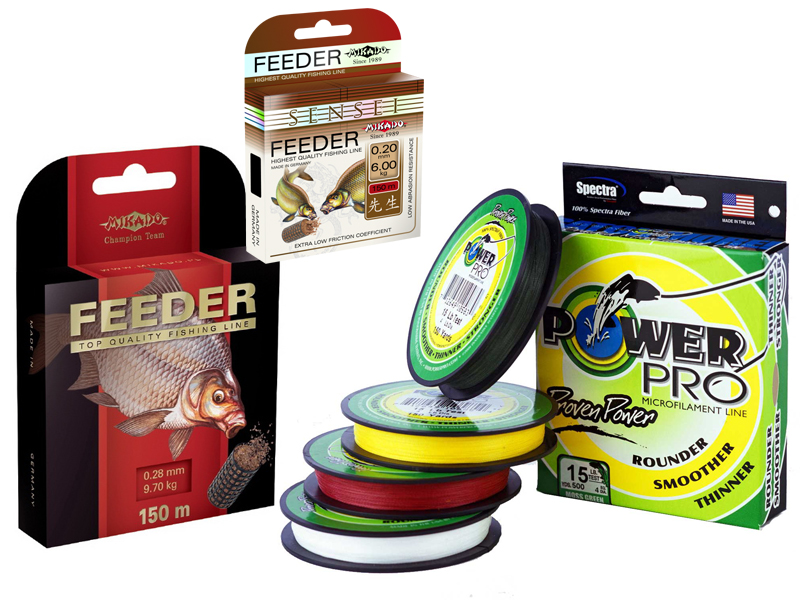
The optimal thickness is 0.2–0.25 mm for monofilament and 0.12–0.16 mm for braided line.
Coil
In principle, there is no big difference which reel to use on the feeder rod, but you should take into account that you will have to throw a large weight of the feeder far, and then reel in an even heavier load - with the catch. Therefore, even for crucian carp, the reel should be large enough and reliable. The optimal size according to the Daiva numbering is from 3000 to 4000. The friction brake can be rear or front - as convenient for the angler.
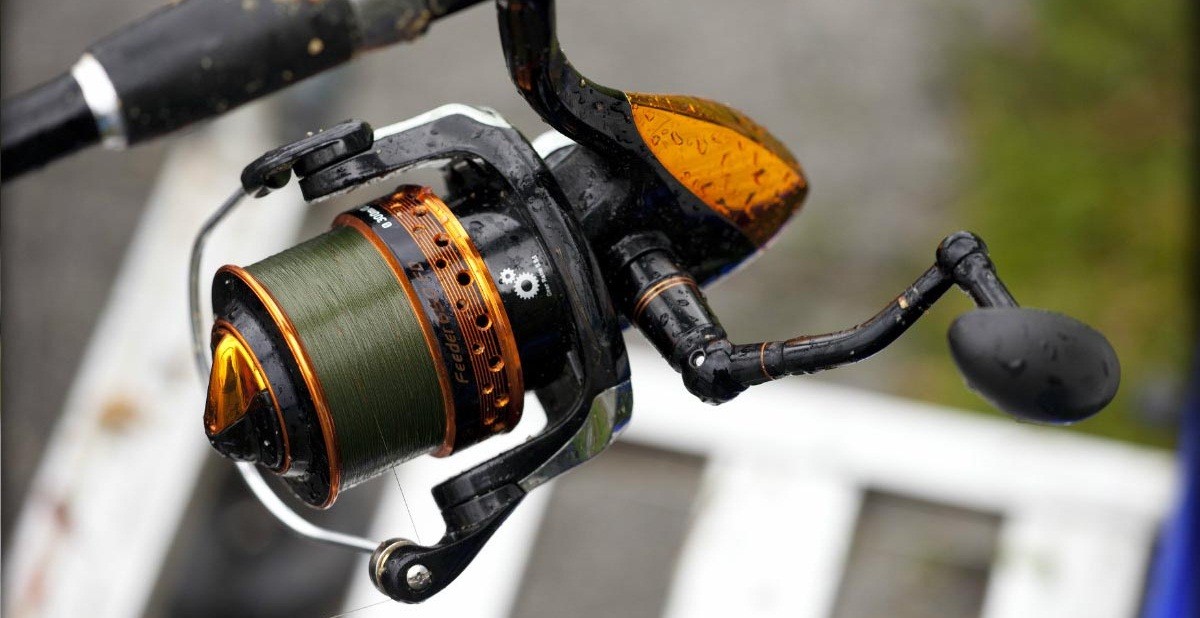 The feeder reel must be powerful
The feeder reel must be powerful Don’t give up on reels with a bayrunner system, which serves to instantly move the friction brake from the working position to the minimum. This will allow you to freely release the fishing line and will prevent large fish that will bite on the bait from leaving.
Leash
For feeder fishing for crucian carp, it is better to take a thin, soft and long leash, with a thickness of 0.07 to 0.09 mm, the material is fluorocarbon. This leash is very durable and almost invisible in the water. The color must be matched to the tone of the bottom. For shock absorption, it is advisable to install a feeder rubber band between the main line and the leash. The length of the leash can be from 15 to 30 cm.
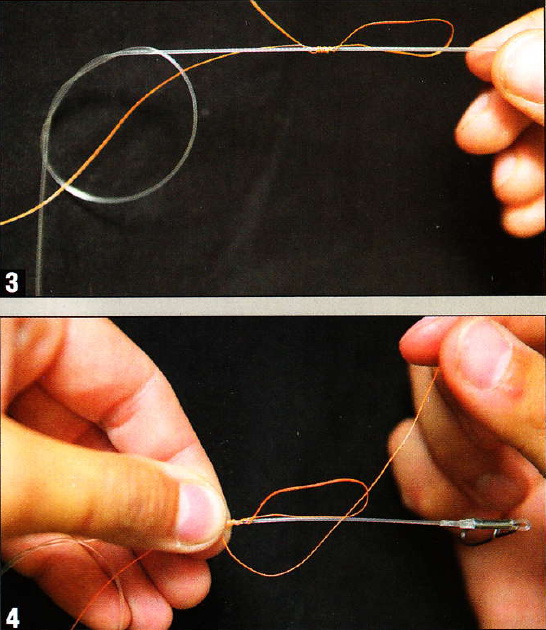 Fluocarbonate leader and its attachment to the fishing line
Fluocarbonate leader and its attachment to the fishing line Hooks
To catch crucian carp, hooks are small, thin, numbers from 20 to 16 according to the international classification. This is due to the fact that the smaller the hook, the more confident the bite will be. Another point: the larger the bait, the smaller the hook number. If you use a worm, then 16–17 with a short shank is suitable, for maggots 17–18, and for using bloodworms – number 20 with an extended shank.
Feeder
The choice of feeder must be approached with special attention. Crucian carp is a lazy fish, it moves weakly, and the more compact the feeding table is arranged for it, the greater the chances of success. You can do this by purchasing a plastic feeder with minimal or no perforation. This design will lose a minimal amount of light bait fraction, thereby creating a local feeding spot. In addition, the bait will begin to work only when it hits the bottom, and will not leave a trail behind it throughout the entire thickness of the water.
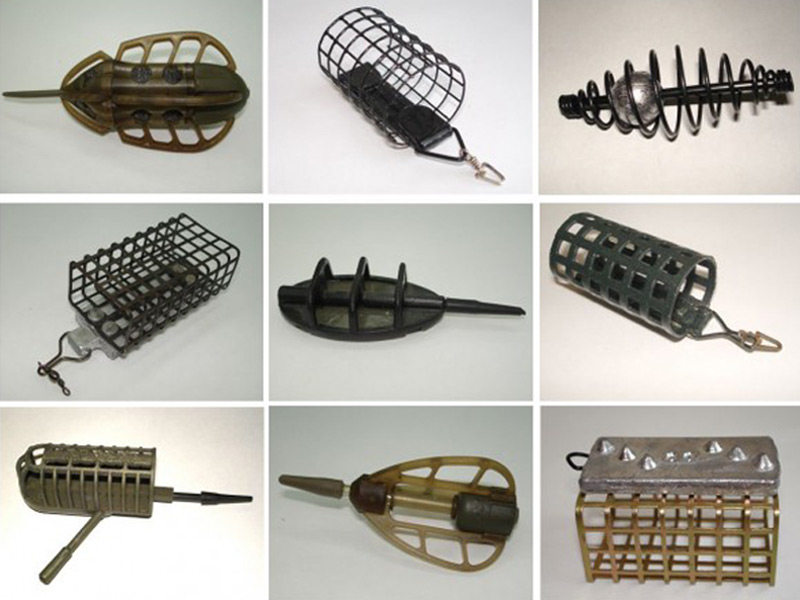 Types of feeder feeders
Types of feeder feeders The feeder is attached to the main fishing line and can be additionally equipped with a sinker (if there is a current in the reservoir, as well as for places with great depth).
How to assemble the equipment
As is known, main task rigging – transfer information about the bite from the hook to the tip of the rod as quickly as possible. And the better the components are selected, the faster the angler will be able to react and hook. There are 5 ways of arranging equipment for a feeder; they have their own characteristics, and they must be selected depending on the fishing location.
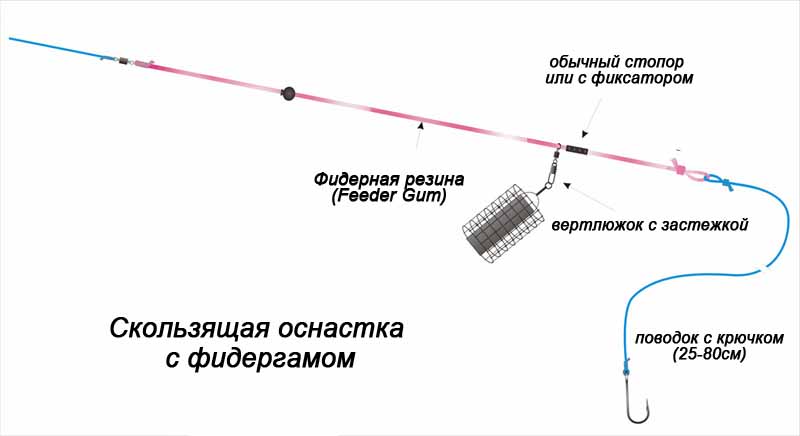 Feeder rigs for light feeder rods
Feeder rigs for light feeder rods Primitive equipment
This is the simplest way and the most ineffective. It’s done like this: the line must be passed through a swivel on the feeder, then a lead pellet or a regular purchased silicone stopper must be put on it. Next, you need to tie the fishing line to the swivel and attach the elastic band, leash and hook.
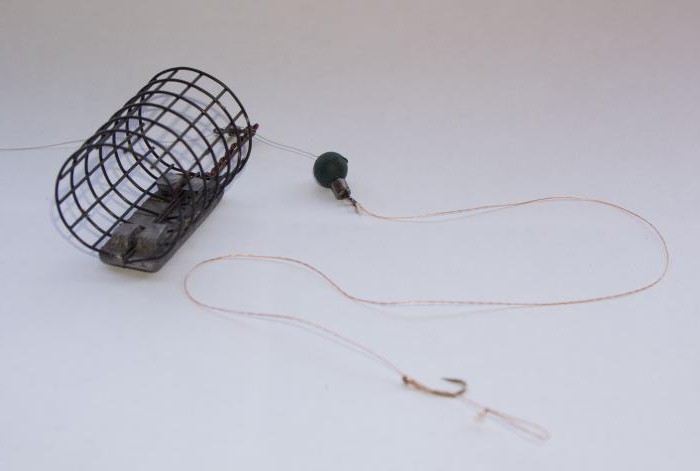 The simplest equipment with a stopper
The simplest equipment with a stopper Equipment with anti-twist
There has been heated debate regarding this type for a long time. Beginners like the promise of no line tangling when casting. Experienced feeders present a whole list of complaints to this system:
- splashes on the water and scares the fish;
- the anti-twist tube constantly breaks;
- The leash is located far from the feeder, which delays the reaction to a bite by a couple of seconds.
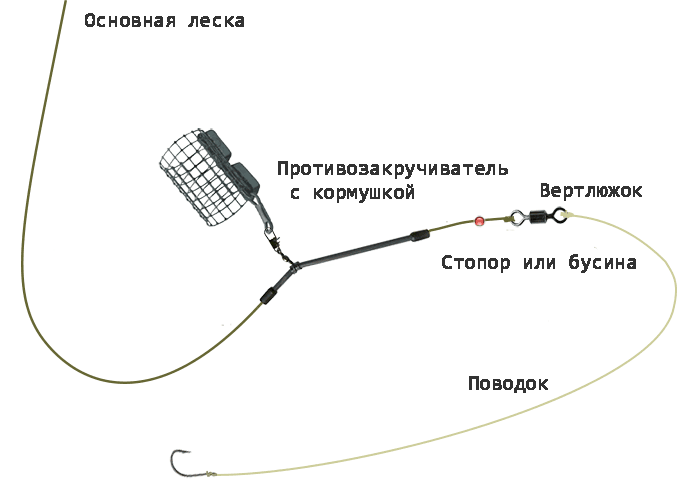 Equipment with anti-twist
Equipment with anti-twist Making such a rig is simple: you need to take a piece of fishing line about 0.5 meters long, tie a swivel to it and string a stop bead, which will prevent the tube from slipping. Insert the fishing line into the finished anti-twist and tie it to the twin swivel. Attach a leash to it.
Paternoster type equipment
It’s simply impossible, and an additional advantage is the high probability of the fish hooking itself. This equipment is more suitable for catching crucian carp in ponds and small slow rivers. There are two options for the paternoster device.
Classical English version does not involve the use of swivels. Just make a small loop at the end of the fishing line - up to 3 cm, and 15-20 cm higher - a larger loop (about 10 cm). It should be of such a size that the feeder can fit through freely. Then the fishing line must be passed through the rings on the rod, a feeder is attached to the large loop, and a leash with a hook is attached to the small loop.
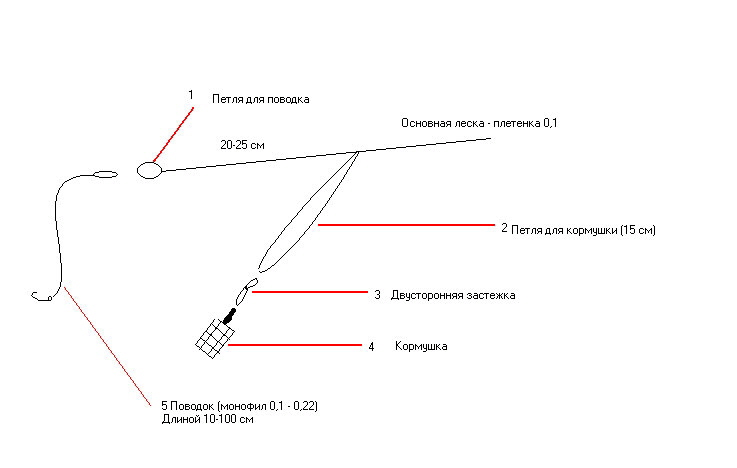 Paternoster type equipment
Paternoster type equipment The second method was invented by our craftsmen and is done like this: a large loop is made at the end of the fishing line - up to 20 cm in length. Then you need to cut it, but not in the middle, into 2/3 and 1/3 of the length. A swivel must be firmly attached to the end of each part. A feeder is attached to them on the short part of the fishing line using a carabiner, and a leash is attached to the long part.
Asymmetrical loop
This is a very sensitive equipment that reacts to any touch of the fish to the bait. A swivel is put on the end of the main line, and then it is tied into a loop up to 50 cm. The feeder is attached and pulled up as much as possible. Below it, 20 cm, a second loop is made using the figure eight method, and a leash is attached to it. The leash is additionally attached to the main line using a carabiner. This system has one drawback - it requires frequent recasts due to overlap. This can be avoided if the leash is made of rigid fishing line.
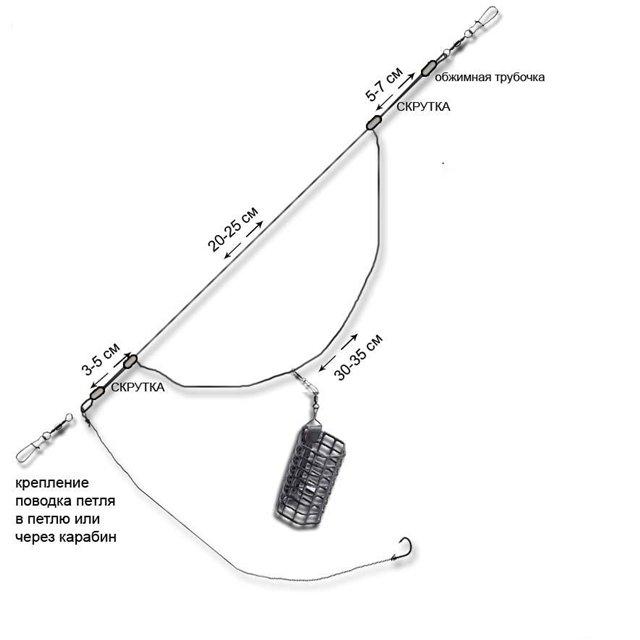 Asymmetrical equipment
Asymmetrical equipment Symmetrical loop
Also simple, convenient and sensitive equipment for crucian carp in any reservoir, which is placed directly on the main fishing line without the use of additional elements. On the end part of the fishing line folded in half approximately 50 cm, a 3 cm loop is made at the end. A swivel with a carabiner is attached to the free end of the main part of the cord - for the feeder. And on the loop there is a leash (loop to loop).
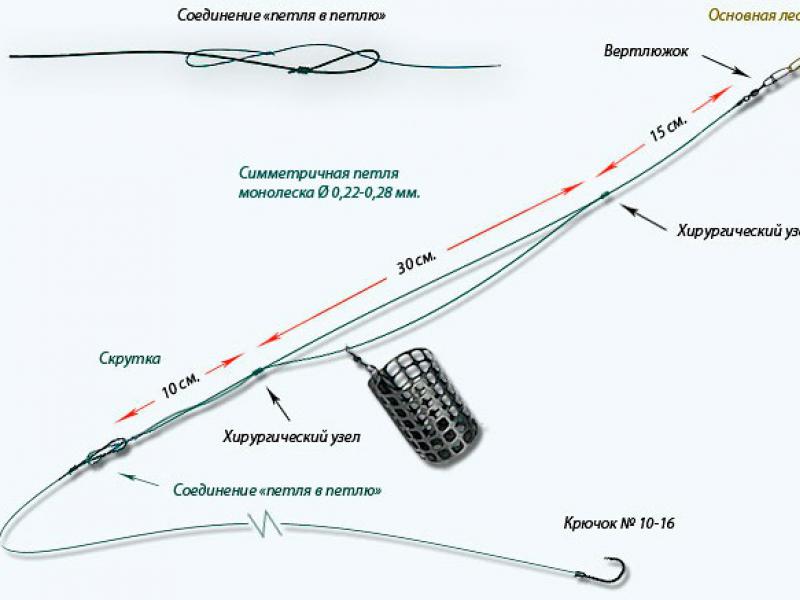 Accessories symmetrical hinge
Accessories symmetrical hinge If the main line is very thin and soft, then it is preferable to make the equipment from a more rigid separate material, and then attach it to the main part.
Feeder is the ideal tackle for crucian carp
Although crucian carp is a simple fish, not everyone will be able to catch it. The advantages of a feeder over a fishing rod, spinning rod and regular donkey are:
- the feeder allows you to effectively fish at very impressive distances, which does not frighten cautious fish;
- with this kind of fishing, you can free your hands - eat, prepare complementary food or drive away midges;
- during the time that the feeder lies motionless on the bottom, the fish have time to both find feeding and bite;
- on the other hand, if there is no bite in one place, the feeder allows you to quickly change and feed a new promising area.
Photo gallery: Crucian carp caught by feeder
A successful catch on the feeder It was a good day Trophy crucian carp Spring crucian carp caught on the feeder
Video: feeder fishing for crucian carp
How to catch crucian carp on a feeder
Preparation for fishing begins with choosing the first casting location - by tapping the bottom with a slingshot. The next stage is initial luring, which is performed by casting several large feeders with a distance of 5 meters between them. This will attract fish from nearby places. After about ten minutes you can start fishing, making the first cast to the center of the feeding zone.
If there is wind, the first casts may not work - you will have to practice. You need to fish, trying to create a minimum amount of noise, and recast at the beginning of fishing at a low pace.
Advice! For the most efficient work with a feeder tip, the tip of the rod should be positioned as close to the water as possible, and the hook should be made with a wide and gentle movement to the right or left. If you make a sharp upward hook, the line cuts the water too much and stretches, which will reduce the percentage of bites sold. With a wide sideways movement, water resistance is minimal, and the effectiveness of hooking is very high.
Groundbaits and baits for crucian carp
The choice of bait depends on many factors: the type of fish, the strength of the current, the type of bottom of the reservoir.
For crucian carp you need to take ready-made complementary food for carp or prepare it yourself - based on cake, steamed feed or various cereals (corn, peas, pearl barley).
Crucian carp, by the way, prefer pearl barley.
Flavorings are added to the porridge (you shouldn’t get too carried away with them - this can scare away the fish), and they also make “porridge with meat” - they add bloodworms, chopped worms or maggots. If the complementary food is very light, you can weigh it down with the help of soil, which is best taken directly at the fishing site.
The essence of bait is that it should attract fish to the fishing site, but not saturate it. It is important not to overdo it with the amount of high-calorie additives - bloodworms, maggots, otherwise the fish will quickly get full and lose interest in the bait.
The proliferation of feeder gear has made bream the favorite catch of most anglers. But this large, strong fish with excellent fighting qualities is not for everyone. Catching bream on a feeder in summer is much more difficult than autumn and spring fishing, when it is enough to throw any gear and the catch is already in your hands. During the warm period, the fish feed little and bite sluggishly and reluctantly.
Whoever gets up early gets a bream bite
Heat and bright sun reduce the desire of fish to consume food, including our bait and bait. At noon you can pour out several buckets of expensive bait and the result will be minimal, so fishing for bream in the summer on a feeder requires first of all the right choice time period.
Starting from July and ending in mid-August, that is, when the heat is at its strongest, bream bites best at night. In other months, night fishing will not bring you any significant catch.
If you don’t want to sit with a flashlight, then you can get by with the dawn and sunset hours. In the morning, the bite lasts from 4 to 8-9, later the heat sets in, and the fish go into the pits, where they react weakly to our feeder. In the evening, schools of fish come out to feed from 6 o'clock.
On shore and underwater
Having decided on the time for catching bream with a feeder in the summer, you should stop there. Not many fishermen pay enough attention to examining the bottom of the reservoir, believing that future prey is kept closer to the middle of the river. In some ways they will be right - bream indeed often stays on the main channel, forming a “bream table”, but there are other areas where it also prefers to feed.
Bream most often feed on the edge and exits from pits.
For promising places where you plan to fish regularly, you should make a bottom map. To do this, examine the channel with a sinker or an empty feeder. Schematically write down the data on a piece of paper, where you mark the slope, edge, main channel, holes.
Lure and Fish
In order to catch bream with a feeder while fishing in the summer, you should stock up on bait that meets the following qualities:
- aromatic;
- fine grinding;
- low content of large particles;
- contain animal components.
Complementary food should be prepared on the shore, gradually adding water and checking the food ball in shallow water. Too sticky bait will not come out of the feeder and form a food spot, and the loose substance will easily spread throughout the entire reservoir, and bream will not gather in your feeder fishing spot.
For summer fishing on the feeder, the gear should be as light as possible. To do this, we set the thinnest leash with a minimum length of 30 cm. The hook should also be set small so that the bream can swallow it better.
Crucian carp is an unpredictable fish. Usually everyone is used to fishing close to the shore. But in this case you can catch small fish. Catching crucian carp on a feeder is more effective.
The feeder allows you to catch larger crucian carp, which stays away from the shore in the depths. The efficiency of using feeder gear is increased through the use of a feeder. You can throw not only equipment, but also bait over a long distance.
1. Rod
The choice of rod depends mainly on the expected casting distance. The feeder length can be from 3 to 3.6 meters. The further the expected distance, the longer the feeder should be. A rod up to 4 meters long is unjustified.

Casting at a distance of up to 100 meters and no longer will be needed to catch crucian carp. According to the dough, you can use ultra light, light and medium tops, with dough from 30 to 80 grams. The use of large loads is not justified. Crucian carp, unlike carp, can quickly get enough and lose interest in the bait. According to the action, it is recommended to use soft or medium rods.
There are no special requirements for the feeder reel for crucian carp. This can be any reel with a front or rear friction brake. With a spool size of up to 3000. Large sizes are unjustified, the crucian carp is not strong enough to reel in even a few meters, and the available size is enough to restrain a small carp.

Using large, heavy reels will only unbalance and make the tackle heavier.
3. Fishing line
Since the feeder tackle is quite complex, it uses two types of fishing lines. Main line and leash line. As the main line, you can use either a braided cord with a diameter of 0.14 - 0.16 mm or a monofilament line with a diameter of 0.2 - 0.25 mm.
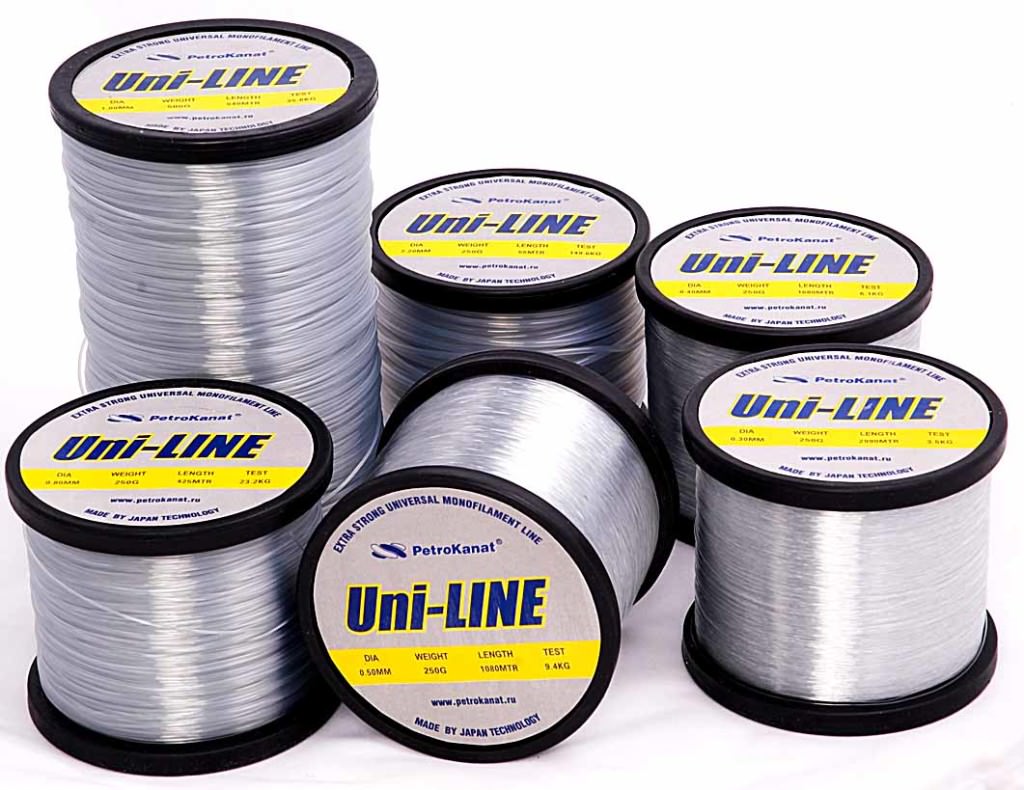
There are no special preferences for using the line option. Braided cord does not have the same need for its use as in spinning gear, where constant control of the bait is necessary.
Feeder gear involves freely placing a leash on the bottom so that the crucian carp can calmly take, taste the bait and swallow it without immediately spitting it out. This means that constant monitoring of the bait is not necessary. Monofilament thread can easily handle the tasks of the main line. In addition, it is an order of magnitude cheaper than braided cord.
For the leash, it is quite possible to use monofilament fishing line with a diameter smaller than the main fishing line. Typically, leashes of 0.1 - 0.14 mm are used.

When catching cautious fish, even thinner lines are used.. Fluocarbon can also be used, but it must be taken into account that, despite its invisibility, it is a more rigid material than monofilament. If the bite is weak, you always need to experiment not only with baits, but also with materials and leash length.
5. Feeder
The choice of feeder weight and rod test are directly related. The greater the mass of the feeder, the larger the test should be. Conversely, the larger the tip test, the heavier the feeder can be used. Depending on the shape, you can use different types of feeders.
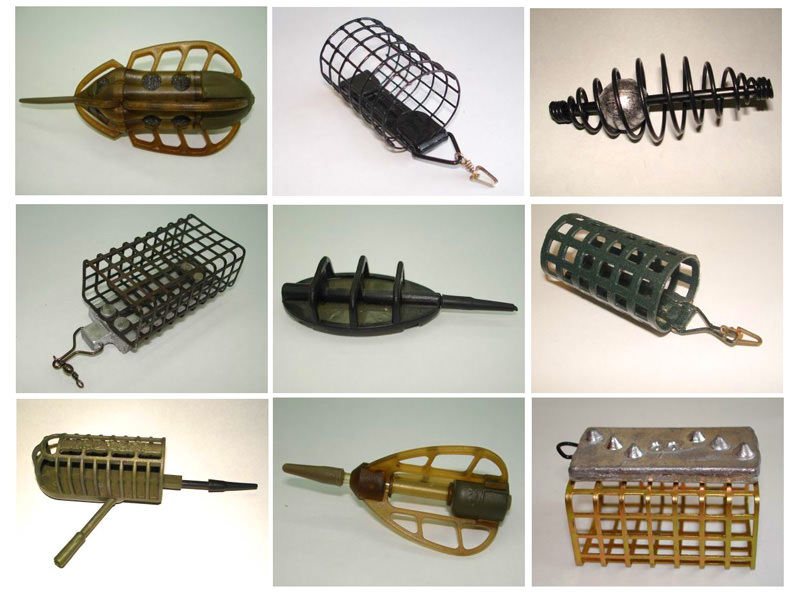
If there are a lot of snags and stones at the bottom on which the feeder can get caught, then it is better not to use feeders in the form of cages, but to use special streamlined feeders. In spring, crucian carp come to the shore, where the water warms up faster; the shape of the feeders does not matter. In summer, crucian carp move away from the shore, so cone-shaped feeders are used for long-distance casting.
Feeder equipment
There are quite a lot of options for equipment for feeder fishing, more than 15 installations. The specific installation is used depending on the fishing conditions. The easiest to use and satisfying most fishing conditions is the Paternoster installation. It is convenient and easy for beginners to learn and use.
Manufacturing:
Two loops are knitted on the main line. One is small, at the end of the fishing line. A leash with a hook is attached to it. The second is large, its size should allow the feeder to pass through it. It is knitted at a distance of 30 cm from the place where the leash is attached. The feeder is attached to the large loop via a swivel or clasp.
Installation
Installation of gear begins with collection. We place the tip depending on the fishing conditions (weight of the load). Next we place the reel with the main fishing line. We pass the fishing line through the rings.
At the end of the main line we make a loop to which the equipment will be attached directly. The equipment can be made directly on the main fishing line, but for convenience it is better to knit various equipment at home. When fishing, one equipment can be replaced with another without cutting off and throwing away the first installation.
How to catch more?
Over 7 years of active fishing, I have found dozens of ways to improve the bite. Here are the most effective ones:
- Bite activator. This pheromone additive attracts fish most strongly in cold and warm water. .
- Promotion gear sensitivity. Read the appropriate manuals for your specific type of gear.
- Lures based pheromones.
Choosing a fishing spot
To select a fishing spot, you need to find a section of the coast without bushes and trees in order to safely cast the gear. If the reservoir is unfamiliar, then you need to study the bottom using a marker float, or by counting the time when an empty feeder or a regular sinker falls. It is necessary to choose a place without a current.
Crucian carp loves calm water. We are looking for a fairly large area with a flat bottom, which is called a “table” in the fishing community. It is on a flat area that it is best to feed, luring crucian carp. If there are several feeder rods, then it is better to choose several different points both in depth and in distance from the shore.
Lure
Bait is the most important component when fishing with a feeder. It is this that is capable of attracting cautious and large crucian carp to the bait. The bait can be of different composition. You can prepare it yourself or purchase it at the store.
1. Purchased mixtures
If you don’t want to get involved with making complementary foods yourself, you can purchase them at the store. There are a lot of complementary food manufacturers, but you need to choose a well-known seller.
The bait mixture must be fresh. It includes all the necessary components that attract and hold crucian carp at the feeding site. Using store-bought mixtures from well-known brands is quite expensive.
2. Making your own bait mixture
Complementary food for crucian carp can be made at home, and just mix it in a pond. As a rule, the composition of complementary foods is small. The following composition can be used:
- Twisted sunflower seeds in a meat grinder (combine) into 2 parts.
- Breadcrumbs 3 parts.
- Bran 1 part.
- Boiled millet 1 part.
- Hercules porridge 1 part.
- Corn flour 1 part.
- Flavors.
In fact, there is no ideal complementary feeding option for crucian carp. He is so picky that his preference can change in a matter of hours.
3. Combining mixtures
To save costs on bait, you can mix ready-made mixtures with the base for making your own bait, that is, breadcrumbs. The flavorings in purchased complementary food will be enough to attract crucian carp to the fishing site.
You can combine complementary foods on a pond. To do this, you need to take several baits of different tastes, and a homemade base for diluting store-bought bait. In addition, this will save costs.
Baits
Crucian carp is so omnivorous that it can take both animal and plant baits. He buys worms, maggots, pearl barley, corn (steamed or canned), bread, dough,...
What bait to use depending on the time of year. In spring, crucian carp prefers animal baits; it needs as much protein as possible after winter. In summer, he willingly takes vegetable baits (corn, pearl barley, dough, etc.). But this does not exclude the possibility that in summer crucian carp will not take bait on animals.
Fishing technique
Catching crucian carp on a feeder has its own characteristics. After collecting the gear, you need to mix the complementary foods. If the place is not familiar, then we look for promising points. Unlike carp fishing, a promising place is not fed, or only slightly fed.
Crucian carp gets full very quickly. Therefore, the main hope is that he will be attracted to complementary foods in the feeder. You can feed with a feeder, making 3-5 casts with complementary food at one point.
After feeding, we put bait on the hook, fill the feeder and throw the equipment into the fishing spot. You need to mark the fishing spot, find a landmark on the other side, for example, and cast to a certain distance, making a mark on the fishing line. After casting, place the rod on a special stand and tighten the line.
At the moment of the bite, when the rod tip is indicated, you need to wait a little and then hook, but not sharply.
The best time to catch crucian carp on a feeder
You can catch crucian carp after the ice has broken up. He approaches the shore, where the water warms up faster and he is more active after hibernation. A couple of weeks after the ice melts, crucian carp go to spawn. During this period of time, the crucian carp is hungry. After spawning, it takes more than a couple of weeks, after which it begins to feed. Crucian carp is active until autumn.
In some reservoirs it also feeds in winter. If the bottom of a reservoir is muddy, then it buries itself in the mud and goes into “hibernation.” Recommending biting times for crucian carp is a thankless task. Its whim depends on many factors, weather, availability of food, wind, precipitation, etc. The prevailing beliefs about the best bite at dawn and dusk are confirmed, but you can also catch crucian carp successfully during the day.
The nuances of catching crucian carp on a feeder at night
Large crucian carp, like large carp, like to feed at night. The larger the fish, the more careful and timid it is. Since there is more food near the shore, where vegetation prevails, large crucian carp come closer. For night fishing, you need to find the first edge during daylight hours, measure the distance on the fishing line and, at dusk, cast the feeder at the nearest edge. At night, visibility deteriorates, and the flashlights used are not of any use, since crucian carp are afraid of everything, and even the strange light on the shore.
Therefore, it is better to use electronic signaling devices as signaling devices rather than tops. In this case, it is necessary to loosen the clutch and use a sliding installation. It is better to use several rods in night fishing, casting baits at different distances.
In spring, you can start catching crucian carp from April. You need to look for shallow areas of the reservoir. The crucian carp is coming bask in shallow water. There are frequent bites near the shore, a few meters from the water's edge. It is better to put bloodworms, worms, and maggots on the hook. You can use a sinker instead of a feeder, and you can feed the desired point from the shore.
In summer, crucian carp move to deeper areas of the reservoir. To search for promising places, you have to use more powerful gear and heavier feeders. Crucian carp is very capricious in summer, so it is better to catch it in the early hours or at sunset. It is necessary to experiment with complementary foods and bait.
In the fall, crucian carp begin their autumn feeding, so catching them during the day is more successful than in the summer. You can use any nozzles. As the water begins to cool, the crucian carp again approaches the shore.
Features of catching crucian carp in still water and in the presence of a current
Fishing in currents and in still water is slightly different. On the river it is necessary to use only sliding installations of equipment, either a sliding weight or a sliding leader (one of the two). The length of the leash should be increased. This will prevent the leash and line from twisting in the current.
During currents, heavier feeders are used, as they must hold the equipment at the desired point. It is advisable to use feeders with mesh to retain complementary foods. Complementary food is used with a large number of binding ingredients so that it does not wash out, and the aroma of the bait lingers in the right place.
If you have to fish in the current, you will have to feed more. You should throw the feeder just above the chosen place, the feeder should go down in the current until it reaches the bottom. The rod must be positioned at an angle to the water.
- When fishing with a feeder, the chances of catching crucian carp increase many times over.
- Crucian carp is a very cautious fish, so it is recommended to use very sensitive gear, thin fishing lines on a leash.
- In spring, it is best to fish with animal baits in shallow water. In summer, in the morning and evening hours over long distances.
- You can use plant baits when experimenting with complementary foods.
Fishing for crucian carp on a feeder is very common in reservoirs with a muddy bottom and crucian carp large sizes, which are not so easy to catch with a float rod. Cautious crucian carp rarely approaches the shore, and if they see a floatfish bait, it is not at all a fact that they will take it, since adult crucian carp is a very cautious fish.
But using the right feeder equipment and tackle, you can catch large crucian carp and make it easier and more interesting with a feeder.
| Fishing in spring | Fishing in summer | Fishing in autumn |
| Crucian carp is one of the earliest fish that begins to actively feed after the ice melts from reservoirs. This usually occurs 2-4 weeks after the ice melts. The favorite bait for crucian carp when fishing on a feeder in the spring is a worm. The colder the water, the shallower the places you should look for crucian carp; closer to summer it descends to deeper areas. | Fishing for crucian carp on a feeder in the summer is most catchy in June and July; in August the bite subsides. In hot months, in addition to the worm, crucian carp should be offered green peas, dough, bread, corn. On days when the bite is bad, use “sandwiches” of worm + maggot or worm + corn. | In autumn, the bite of crucian carp weakens significantly. In October and November, you can catch crucian carp only in places where there is too much of it and the food supply is poor, the crucian carp is hungry and has to continue to gain fat before wintering. The best bait is again a worm. |
Tackle
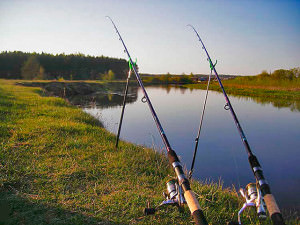
Spinning ≠ feeder rod, there are a lot of differences between them
I will give you the entire list of desired gear and accessories. It's more or less ideal option and, of course, you can use simpler gear, but I will describe why I make this choice.
- Feeder rod: length 3.9 m; the test is not very important, anything from 60 to 120; The best material is composite or carbon, they are the most durable. A feeder rod is a very important component of the tackle; if you think that a regular spinning rod is more convenient and you don’t need to use a rod specifically for a feeder, then you are very mistaken and most likely you have simply never fished with a feeder rod. It is much more massive, stronger and longer than any spinning rod; allows you to make long casts without fear for the safety of the rod.
- Spinning reel with a friction brake (rear or front does not matter, but the front one is often more sensitive, although we will be catching crucian carp, and the opponent is not the strongest - so a friction brake is needed, but you should not get too hung up on it). Spool capacity up to 100 meters of fishing line 0.2.
- Line:(0.2-0.25), less often braided (0.15), there is no fundamental difference. . The most important thing is that the fishing line can withstand the load when fishing, which will be exerted by a large crucian carp.
- Leash:, designed to carry the same load as your main line. The peculiarity of fluorocarbon fishing line is that it is almost invisible in the water, but an important drawback is that it is 2 times weaker in tensile strength, so do not be surprised if the leader is 1.5-2 times thicker than the main fishing line.
- Feeder load for 40-70 g.
Feeder equipment
There are a lot of feeder equipment, and the choice depends on the fishing method and conditions. Since we catch crucian carp in a pond/lake/river on a muddy bottom, it is important for us that the feeder does not sink into a layer of silt, but continues to attract crucian carp and ensures good transmission of the bite to the tip of the feeder rod.
Baits
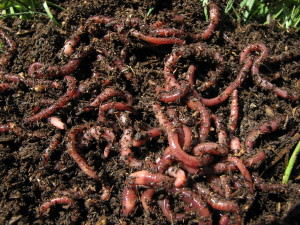
Dung worm is the best bait for crucian carp
There is a wide choice here, but most often they use a piece of worm, maggot, etc.
The entire list of animal baits that crucian carp are interested in almost everywhere:
- Muckworm(California is very similar to dung, so we’ll add it here)
- Earthworm
- Maggot (sometimes the crucian carp bites actively, and sometimes it doesn’t want to take it, it takes it with a worm)
Plant attachments:
- Pearl barley (pearl barley- an excellent bait for crucian carp, especially garlic-flavored barley)
- Canned corn- less popular, but also often used as a nozzle.
- Canned green peas
- Bread and dough
In spring and autumn, it is better to use exclusively worms and maggots as bait. In the summer, crucian carp switches to plant nutrition, here pearl barley and corn are very useful to you, although the worm is still often the crucian carp's priority.
Fishing technique
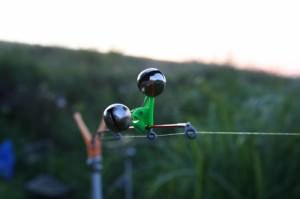
Real feeders do not use bells, because if the fish does not bite for a long time, it is necessary to act, and not continue to watch the silence of the bell
The technique of catching crucian carp with a feeder differs from that of a (load-feeder). Our task is to feed the place well and fish on the “bait table”, when ordinary bottom fishers do not make any feeding casts, but rely on the only prey swimming past the feeder.
- After you have found a flat area at the bottom of the reservoir, fill the feeder with bait and cast to the fishing point. It is advisable to make the first cast with about 80% of your total strength (if you are fishing at a distant line), but if you want to fish 30 meters from the shore and can easily send the feeder a second and third time, then cast as planned at exactly 30 meters. During the first cast, be sure to mark a reference point on the opposite bank, which you will constantly aim at when casting, this way you will ensure that you receive targeted feeding, and we will tell you how to cast at the same distance later.
- After the feeder splashes down, place the feeder rod on, wait until the feeder reaches the bottom, tighten the line by rotating the reel and wrap the line around the reel behind a special clip (stopper). All further casts of equipment with a feeder will reach the same distance and fall into the water in the same place.
- Carefully take the rod in your hands and make a hook, the food from the feeder will fall to the bottom, and you can calmly wind the fishing line onto the reel and pull the feeder weight out of the water to fill it with bait again.
- It is necessary to make from 7 to 15 bait casts (the stronger the current and the further the fishing zone from the shore, the more casts.
- When you have made all the bait casts, place the bait on the hook and send the bait to the fishing zone.
Do not pull the line too tightly while waiting for a bite so that the fish, when taking the bait, does not feel strong resistance.
Now all that remains is to wait for the bite. But you shouldn’t wait too long; if there’s no bite for more than 5 minutes, this is a reason to think about it and recast. But don’t rush, it happens that when the bite is bad, the fish actually behaves very sluggishly and needs a little more time, this is especially noticeable during autumn crucian carp or carp fishing.
Video guide on catching crucian carp on a feeder
The best time for anglers begins immediately after the end of the spring ban. Fish rested after spawning tend to feed intensively at different depths.
Feeding activity is also determined by the final clearing of the water. Typically, in the summer heat, fish leave the shoreline to search for cooler parts of the reservoir. Which means getting it normally float rod quite problematic. Feeder tackle at this time is unusually effective and catchy. This explains the increase in fans of feeder fishing in reservoirs in the summer months. The feeder, without much skill, allows you to throw the tackle to the desired point, feed it and catch large specimens.
It is important to find a deep place, so it is recommended to carry out exploration of the bottom surface of the reservoir. It is quite possible to find fish based on the transparency of the water. The largest specimens of cautious fish species hide from the summer heat in deep holes, under the shore edge or under ravines.
A feeder can be successful in many bodies of water. It is only necessary that the bottom is not overgrown with grass and free of snags. Different fishing circumstances, primarily the nature of the reservoirs, determine the difference in feeder equipment. Based on this, it is recommended to have an arsenal of different fishing rods depending on the speed of the river.
Weather conditions have a huge impact on the success of feeder fishing. When there is a new moon or a change in wind direction, the catch will almost certainly not be significant.
The variety of feeder rods on the shelves of specialized fishing stores is amazing.
From cheap Chinese models to expensive branded fishing rods.
A classic feeder rod is usually equipped with three tips that differ in rigidity. The specific tip should be selected based on the strength of the current. Budget versions of rods can be sold with one tip, the most expensive ones can come with a number of tips or more than three.
The optimal length of a feeder rod for use on rivers is in the range from 2.5 to 3.5 meters. If the shore is free of bushes and trees, and long casting is required, then a long rod is preferable.
The rod must be equipped with a spinning reel. The quantity and diameter of the fishing line determines the size of the spool.
The most important part of the feeder gear is the feeder. It is extremely important to choose the right feeder depending on the speed of the current. The weight of the feeder is determined by the nature of the bottom and the strength of the current.
Usually it is enough to equip the tackle with a feeder weighing up to 100 grams, but there are situations when the weight of feeders reaches 200 grams for use on a fast stream.
The design of the feeder and the mesh cell must be selected so that the feeder is completely free of bait in 5-10 minutes. If the feeder is made of fine mesh, then it is advisable to fill it with looser bait to create a continuous train.
Another important component of the tackle is the fishing line. It is recommended to use monofilament with a thickness of 0.3 mm. The use of leashes is mandatory. Their thickness is usually from 0.15 to 0.25 mm. Typically, the thickness of the leashes does not have a significant effect on the number of bites. Small hooks should be used, as the fish are more firmly hooked and the number of idle bites is reduced.
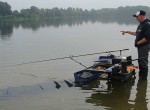
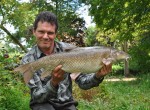
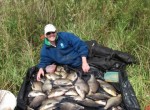
There are several basic options for installing feeder gear. Each of them has both its advantages and disadvantages. There is no obvious leader among them. Each angler uses the installation option that is preferable to him.
The nozzle is quite traditional. These are mainly maggots and bloodworms. For bream, in addition to the usual maggots, worms and bloodworms, very thinly sliced lard or a foam ball are used as bait.
Fishing with a feeder in summer
The success of fishing as a whole directly depends on bait. In summer, plant components will be preferable in the diet. You can use ready-made complementary food and mix it with steamed millet; for predators it is useful to add live food. The bait must be mixed immediately before fishing, using the water of the reservoir. You can use either store-bought bait, make your own, or mix your own and store-bought bait. The consistency of the bait depends on the type of fish.
Feeder fishing consists of two stages. At the first stage, starting complementary feeding of the further fishing site is carried out. To do this, make 10-15 casts in exactly the same place for 5 minutes. When pulling out the feeder, you must make a sharp movement so that the feeder is completely free of food. During starting feeding, it is better to disconnect the leash with the hook to avoid unwanted snags. Having completed the starting complementary feeding, you can move on to the second stage - the actual fishing. At feeder fishing It is very important to always throw the tackle in one place. To do this, you can use a landmark on the other side of the reservoir.
